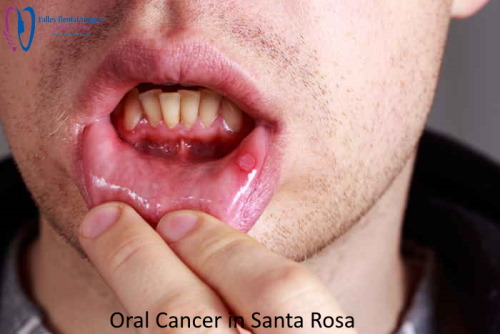Oral Cancer – Lips, Tongue

Valley Dental Surgery & Implant Center Oral Cancer for Santa Rosa Community
A biopsy is required to diagnose mouth cancer. Early detection of oral cancer often provides the best chance of a cure. According to the Journal of Oral and Maxillofacial Surgery, an oral biopsy has an 88.9% diagnostic accuracy. Without insurance, the average biopsy fee ranges from $750 to $1000. Dr. Hani Jamah at Valley Dental Surgery & Implant Center has been performing oral cancer biopsies since 1999, with more than 22 years of experience in this field.
We are close by; contact us if you have any concerns about the cost of a mouth cancer biopsy in , or call us at to make an appointment.
Do I need a Biopsy for cancer in the mouth?
Yes. Your specialist has to acquire a sample of tissue from the affected area to identify mouth cancer. Tissues are then inspected under a microscope to screen for malignant cells.
Tongue Cancer
A type of cancer that starts in the cells of the tongue is called tongue cancer. Common tongue cancer symptoms include a red or white patch on the tongue that won’t go away, a persistent sore throat, a tender spot (ulcer) or lump on the tongue, pain while swallowing, persistent numbness in the mouth, and pain or a burning sensation over the tongue.
Lip Cancer
Lip cancer can arise anywhere along the top or lower lip, although the lower lip is where it usually manifests. A flat or slightly elevated whitish discoloration of the lip, a lip sore that won’t go away, and tingling, discomfort, or numbness in the lips or the area surrounding the mouth are some of its symptoms.
What is the Success Rate of Biopsy test for cancer in mouth?
The reported diagnosis accuracy of oral biopsy is 88.9%, as reported in the Journal of Oral and Maxillofacial Surgery.
How much does a Mouth Cancer Biopsy cost in Santa Rosa?
Depending on your region, the dentist you choose, and the kind of testing you want, getting an oral biopsy might be very expensive. The typical dental charge is between $750 and $1000.
How much does a biopsy for cancer in mouth without insurance cost in Santa Rosa?
Without insurance, a biopsy for oral cancer often costs between $750 and $1000.
How much does a biopsy for cancer inside the mouth with insurance cost in Santa Rosa?
A biopsy should be considered a necessary medical procedure for the insurance to cover the cost. Copays and coinsurance, which often make up 10 to 40% of the total cost for patients with health insurance, are examples of out-of-pocket payments.
What does cancer in the mouth look like?
White or red spots are the most common mouth manifestations of oral cancers. Evaluation is required for any white or red patches that don’t go away after a few weeks; red patches are marginally more concerning.
Premier dentist for mouth cancer biopsies – Dr. Hani Jamah
With Valley Dental Surgery & Implant Center, Dr. Hani Jamah will guide you through the procedure to ensure that you will receive an accurate diagnosis and therapy thanks to his significant experience in oral cancer biopsy and treatment. Dr. Hani Jamah, a specialist in mouth cancer biopsy, provides free consultations to help you decide the best method and price for your oral biopsy.
What is cancer in the mouth?
The term “mouth cancer,” which also goes by the names “oral cancer” and “cancer of the oral cavity,” is frequently used to refer to a variety of tumors that develop in the mouth area. They often start on the lips, tongue, or floor of the mouth, but they can also begin on the cheeks, gums, roof of the mouth, tonsils, and salivary glands.
What is biopsy for cancer in the mouth?
A biopsy entails removing a small piece of the injured tissue and checking it for cancerous cells. The two main methods used to take a biopsy in situations of suspected oral cancer are an incision or a punch biopsy.
What are the Different Types of Biopsy Services used to diagnose Mouth Cancer?
- Incision biopsy: done under local anesthesia if the diseased area is readily accessible, such as on the inside of your cheek or your tongue. The surgeon will cut out a little portion of the damaged tissue after the area has been numbed.
- Punch biopsy: performed by removing a still smaller amount of tissue without the need for stitching.
- Fine Needle Aspiration Cytology (FNAC): used if you experience neck swelling that may be secondary malignancy from oral cancer. Typically, it takes place concurrently with a neck ultrasound scan. With a very fine needle, a small sample of cells and fluid is removed from the bump.
Affordable Mouth Cancer Biopsy Service Near Me in Santa Rosa, California
Looking for Oral Cancer Biopsy Service Near Me? See our dental office location and directions.
About Santa Rosa
Santa Rosa is a city and the county seat of Sonoma County, in the North Bay region of the Bay Area in California. Its estimated 2019 population was 178,127. It is the largest city in California’s Wine Country and Redwood Coast. It is the fifth most populous city in the Bay Area after San Jose, San Francisco, Oakland, and Fremont; and the 25th most populous city in California.
Before the arrival of Europeans, what became known as the Santa Rosa Plain was occupied by a strong and populous tribe of Pomo natives known as the Bitakomtara. The Bitakomtara controlled the area closely, barring passage to others until permission was arranged. Those who entered without permission were subject to harsh penalties. The tribe gathered at ceremonial times on Santa Rosa Creek near present-day Spring Lake Regional Park.
Following the arrival of Europeans, initially Spanish explorers and colonists, the Pomos were decimated by smallpox brought from Europe. Social displacement and disruption followed. By 1900, the Pomo population had decreased by 95%.
Santa Rosa was founded in 1833 and named by Mexican colonists after Saint Rose of Lima. The first known permanent European settlement here was the homestead of the Carrillo family of California, in-laws to Mariano Guadalupe Vallejo, who settled the Sonoma pueblo and Petaluma area. In the 1830s, during the Mexican period, the family of María López de Carrillo built an adobe house on their Rancho Cabeza de Santa Rosa land grant, just east of what later became downtown Santa Rosa. By the 1820s, before the Carrillos built their adobe in the 1830s, Spanish and Mexican settlers from nearby Sonoma and other settlements to the south were known to raise livestock in the area.
According to the United States Census Bureau, the city has a total area of 41.50 sq mi (107.5 km2). Of that area, 41.29 sq mi (106.9 km2) is land and 0.205 sq mi (0.5 km2), comprising 0.49%, is water. .
The city is in the watershed of Santa Rosa Creek, which rises on Hood Mountain and discharges to the Laguna de Santa Rosa. Tributary basins to Santa Rosa Creek lying significantly in the city are Brush Creek, Matanzas Creek, and Piner Creek. Other water bodies within the city include Fountaingrove Lake, Lake Ralphine, and Santa Rosa Creek Reservoir.
In the United States House of Representatives, Santa Rosa is in California’s 5th congressional district, represented by Republican Tom McClintock. It was moved to the district beginning with the 2013 Congress. In the 1980s, future U.S. Senator Barbara Boxer was Santa Rosa’s representative.
In the California State Legislature, the city is in California’s 2nd State Senate district. The city is split between California’s 2nd and 10th State Assembly districts.
The city’s Mayor is Chris Rogers, its Vice Mayor is Natalie Rogers, and the other five council members are Eddie Alvarez, Victoria Fleming, Jack Tibbits, John Sawyer, and Tom Schwedhelm.
The city council in 2013 adopted a set of “Goals and Strategic Objectives” through 2015 comprising six main goals. A “strong, sustainable” economy topped the list; other goals include showing leadership in environmental and cultural issues, and promoting “partnerships between neighborhoods, community organizations, schools, and the City”.
According to the California Secretary of State, as of February 10, 2019, Santa Rosa has 91,998 registered voters. Of those, 47,905 (52.1%) are registered Democrats, 15,260 (16.6%) are registered Republicans, and 24,012 (26.1%) have declined to state a political party. Source: (Wikipedia)
